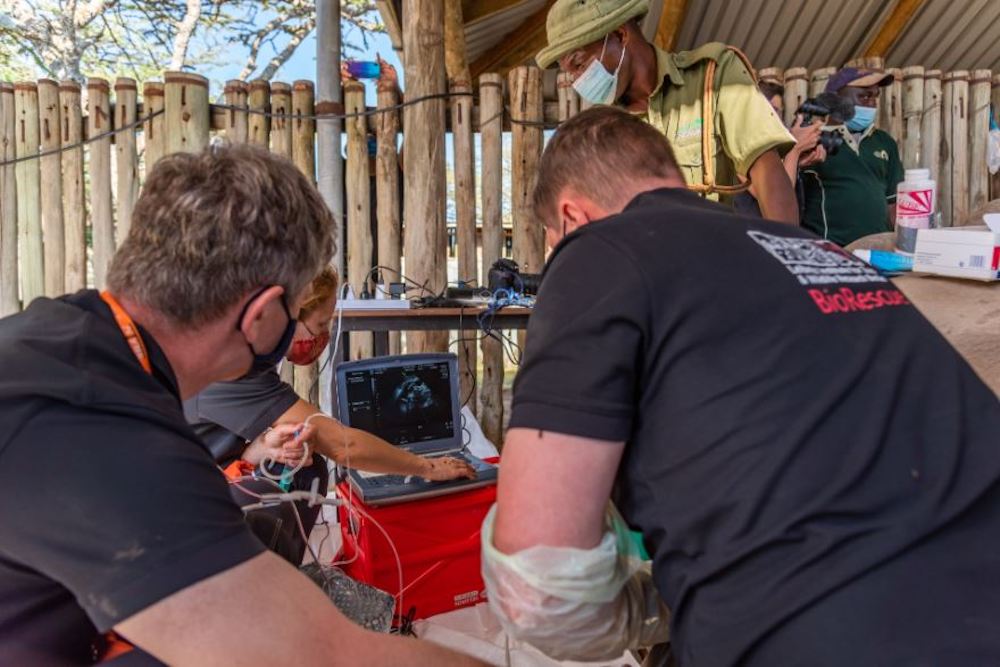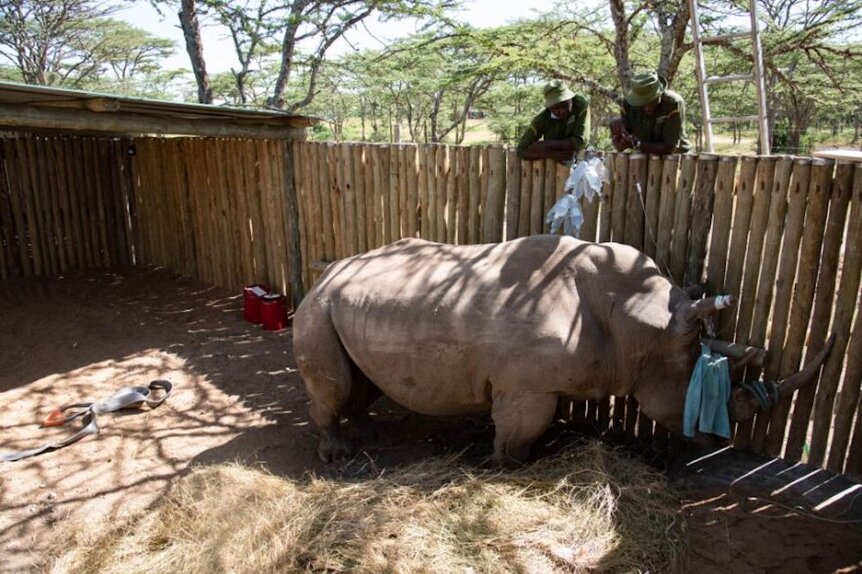Create a free profile to get unlimited access to exclusive videos, sweepstakes, and more!
Frozen lab-grown embryos, a hail Mary for the northern white rhino
The next northern white rhino to be born would have two moms and a dad who died years ago.

Some scientists believe that we are currently in the midst of a sixth mass extinction event. The results of that extinction are unfolding all around us, often without our having realized until it’s too late, if we even notice at all. Sometimes, however, a beloved species of animal declines in numbers and we take notice. That has been the case with the northern white rhino, a lumbering giant whose numbers have fallen so drastically that the species is functionally extinct in the wild.
At present, there are only two northern white rhinos left. Both of those individuals — named Fatu and Najin — are female, meaning there’s no chance of natural reproduction. If things were allowed to follow their course, this subspecies of rhinoceros would vanish from the face of the Earth with the death of this last generation.
That’s where BioRescue, an international consortium of scientists and conservationists, comes in. Steven Seet, a member of BioRescue’s project management and Head of Science Communication, spoke with SYFY WIRE about their efforts to save the species through assisted reproduction, utilizing preserved tissues from living and deceased white rhinos.
“In the very early days our institute started to collect samples from different species and store them in liquid nitrogen. The idea was maybe we could use the material in the future. It turns out, year by year, more species are going down the road to extinction and those databases are becoming more and more important,” Seet told SYFY WIRE.
Conservation efforts often focus on reducing human interference and preserving natural habitats, in order to allow a species to save themselves without our meddling in their affairs. Seet believes that in some instances meddling is exactly what needs to happen.
“In our experience, if a population has less than 50 individuals, it will die out. You have diseases and internal conflicts, you have catastrophes. There are so many challenges and statistically a species will be wiped out,” Seet said.
Once the last of the male northern white rhinos died, the question of whether or not the species could recover on its own was settled. Without help, they would disappear. That’s when BioRescue realized they had sperm cells from northern white rhinos preserved in their tissue collection.
There aren’t any living males, but their biological information still exists and could be reintroduced to the population. All they needed were some viable eggs. But it isn’t as simple as implanting the two remaining females with the preserved sperm.
Najin is Fatu’s mother and is past her reproductive prime. An ethical risk assessment suggested she may not be able to successfully carry a rhino calf to term. Moreover, impregnating one or both of the remaining females necessarily locks up their biology for the duration of gestation, a period of 16 to 18 months. Instead, the team decided they would harvest eggs, also known as oocytes, from Najin and Fatu in hopes of creating embryos which could be implanted in southern white rhino surrogates.
To date, the team has successfully created 14 northern white rhino embryos utilizing Fatu’s eggs and the preserved sperm of four deceased males.
“We have to let the embryos mature outside the body. They need the right temperature and conditions. We use an incubator and then produce an embryo. Right now, we have fourteen, they’re stored in liquid nitrogen. We’ve also produced southern white rhino embryos which we’re using to test how we can perform embryo transfer,” Seet said.
Because the northern white rhino embryos are so rare, the first test cases are using southern white rhino embryos. Recently, the team successfully implanted two embryos into a surrogate rhino and are awaiting confirmation that implantation resulted in a pregnancy.
Counterintuitively, a living male rhino is still a participant in the whole process. The team selected a male who has already successfully reproduced several times and sterilized him. The male has two roles in the assisted reproduction process. First, he alerts scientists to females who are ready and willing to reproduce. Because females send social signals when they’re reproductively active, the behavior of males is a reliable signal.
“If he jumps on the cow, then we know she is ready to receive. The second impact is the action from the male will turn on the systems in the female because she thinks something is happening and has to prepare. The idea is we observe the behavior and as soon as the bull jumps on, we get a call, we head to Kenya, and we do an embryo transfer,” Seet said.
The bull also provides indications after the fact, about whether or not a pregnancy might have been successful. If, after a few weeks, the bull attempts to mate again, that’s a good signal that a pregnancy did not occur.
So far, it’s been several weeks since the successful embryo implantation of a southern white rhino embryo and the team is preparing to travel to Kenya to confirm. If the test case was successful, next steps are to implant a northern white rhino embryo sometime later this year.
If all goes well, some time in 2023 or 2024 we should have the first new northern white rhino calf, descended from a male who is no longer living. With any luck, it will only be the first of many.



























